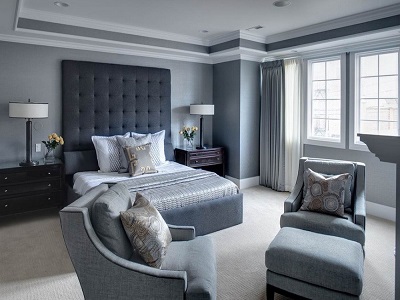The term "monochromatic" is frequently used in interior design and decorating, but what exactly does it mean? More importantly, how can monochromatic scheme interior design be used to create a revitalising living space, an inspiring workspace, or a fun entertainment area?
In this post, we'll look at what monochromatic means in the world of interior design and how to apply the concept to make the most of any space.
What is the definition of monochromatic interior design?
The term "monochromatic" literally means "one colour," but this does not always imply using a single colour to decorate an entire room! Instead, monochromatic interior design refers to the use of various shades, tones, and tints to create different hues, effectively broadening the impact of a single colour. If you want to decorate a space with red, you could use a variety of shades such as vibrant pinks, bold scarlet, or dark maroon to add variation to the design.
Of course, using a single colour to decorate a room will inevitably overwhelm it, but using variations of that colour can have the opposite effect. To learn more, consider the following seven simple ways to incorporate a monochromatic scheme into your home or workspace:
1. Choose Your Color Scheme
Once you've decided on which colour to use as the foundation of your monochromatic interior design, you can start experimenting with colour palettes. You'll be able to incorporate various shades, tones, and tints into your interior design here.
Whether you use two or ten different colours to decorate a room, your colour palette will have a significant impact on the overall effect. As a result, it's important to take your time and experiment with different colours before making a final decision. After all, natural light in the space, as well as room dimensions and artificial lighting, can all influence how a colour appears.
You can finalise your monochromatic colour palette by starting with a blank canvas and experimenting with different shades in different areas of the room.
2. Use prints and patterns to add visual interest.
When you’re using a monochromatic interior design scheme, don’t limit yourself to using only blocks of colour. While a burst of block colour can be effective when used sparingly, covering the entire room in block colour will quickly become boring. Instead, add visual interest by using prints and patterns in the tones, tints and shades of your colour pattern.
3. Use different textures to add depth.
You can add depth to a room simply by incorporating different textures into your interior design, in addition to using prints and patterns to create visual interest. Even a combination of sleek, glossy paint and a matt finish can add depth to a specific area and create a more polished finish. But it doesn't stop there.
When choosing furniture, artwork, and decorative accessories for the space, make sure to include a variety of textures. You can increase the depth of your design and create a visually exciting and appealing space by using varying textures and selecting pieces that match your style.
4. Don't Get Stuck in Black and White
Many people believe that'monochromatic' refers to a black and white colour scheme, but this is not the case. While true black, carbon black, black red, graphite, deep grey, charcoal, and black olive can all be used to create a stunning monochromatic interior design scheme, you don't have to limit yourself to just one colour. Instead, start with a colour you like in a specific space and then use a colour chart to identify the various shades, tones, and tints that will work well within the design.
5. Use at least three different colours.
It can be difficult to decide how many shades or hues to incorporate into one space when using a monochromatic scheme interior design. To achieve a varied yet cohesive look, you should aim for at least three shades. Choosing a dark, middle, and light shade allows you to experiment with different tones and tints while adding light and depth to the space.
You don't have to limit yourself to just three colours, either. If you want to add more hues to your colour palette, simply look for shades that share the same base colour and feature different tones.
6. Allow Contrasting Colors Attract the Attention
Contrast is an important visual communication principle. It can transform a simple accessory into a focal point and draw attention to wherever you use it. Even when using a monochromatic scheme for interior design, contrast can be used to distinguish between features in a room.
If you want to use blue as a base colour, you could have a deep blue sofa with cornflower cushions, for example. Alternatively, contrasting a lime green with a forest green will produce the same effect, allowing you to use your monochromatic colour scheme to highlight features in any room.
7. Include a Neutral Color
A true monochromatic interior contains only one colour in varying shades and tones, but this can be overwhelming. Include a neutral shade to 'break up' the monochromatic colour to add balance. A white kitchen island, for example, can look fantastic in a monochromatic colour scheme, while a dove grey armchair can be a great neutral option in a monochromatic room.
Using Monochromatic Interior Design in Your Home or Office
Color theory can help you create the look and feel you want, from soothing tones for relaxing spaces to vibrant hues for motivating environments, and with these top tips, you've got everything you need to start planning your very own monochromatic interior

